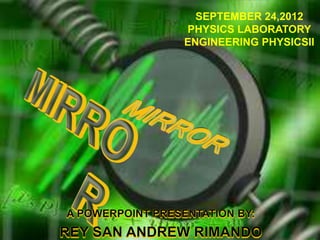
Mirror - Physics by: Rey San Andrew Rimando
- 1. SEPTEMBER 24,2012 PHYSICS LABORATORY ENGINEERING PHYSICSII
- 2. A mirror is an object with at least one polished and therefore reflective surface. The most familiar type of mirror is the plane mirror, which has a flat surface. Curved mirrors are also used, to produce magnified or diminished images or focus light or simply distort the reflected image.
- 3. Three Types of Mirrors 1. Plain Mirror - is a mirror with a planar reflective surface Note: A flat mirror reflects light rays in the same order as they approach the mirror
- 4. How Plain Mirror works? For the Plain Mirror, the light reflected according to the Law of Reflection When a light ray is incident upon a reflecting surface, the angle of reflection is equal to the angle of incidence. Both of these angles are measured relative to a normal drawn to the surface. The incident ray, the reflected ray, and the normal all lie in the same plane. P.S. Reflection – bouncing back from a surface
- 5. Two Kinds of Reflection Diffuse reflection When rays are reflected from a rough surface, they are reflected in many directions and no clear image is formed. None of the normal drawn to the surface (at the point at which the incident light ray strikes the surface) are parallel. Regular reflection When rays are reflected from a smooth surface, they are reflected so that a clear image is formed. The reflected rays are nearly parallel. The normal drawn to the surface (at the point at which the incident ray strikes the surface) are nearly parallel.
- 6. When the eyes receive these light waves, it looks as if the waves are diverging from behind the mirror, making it appear as if the object is behind the mirror as well. This type of image is called a VIRTUAL IMAGE, because light waves do not actually pass through that point, it only appears so. The distance between the object and the mirror is called the object distance and the distance between the virtual image and the mirror is the image distance. Notice that on plane mirrors, the object distance is equal to the image distance. Here’s how the REAL OBJECT and the VIRTUAL IMAGE works.. The Formation of the Real Object & Virtual Image
- 7. Characteristics of a Plain Mirror Object size = image size Object distance = image distance Orientation = erect Always forms a virtual image Image is reversed, left to right
- 8. Dotted lines Shows the Apparent Ray source Angle of incidence = Angle of Reflection For each ray
- 9. Three Types of Mirror 2. CONCAVE MIRROR Concave mirrors reflect light inward to one focal point, therefore they are used to focus light. Unlike convex mirrors, concave mirrors show different types of image depending on the distance between the object and the mirror itself. These mirrors are called "converging" because they tend to collect light that falls on them, refocusing parallel incoming rays toward a focus. This is because the light is reflected at different angles, since the normal to the surface differs with each spot on the mirror.
- 10. Characteristics of Concave Mirror The focal length is positive (because the object and the focus are on the same side of the mirror) The object and the focus are on the same side of the mirror (inside the arc) Real images can be formed by the mirror when the object is outside of the focus; an inverted image is formed Virtual images are formed by the mirror when the object is within the focus; an erect image is formed No image is formed when the object is at the focus When the object is at the center of curvature, an inverted image is formed at the center of curvature
- 11. Real Focus Parallel rays Focal length = + Forms real, inverted, Reduced or enlarged Reflected rays Image. Also forms Virtual, erect, Enlarged images.
- 12. Object beyond 2f Parallel ray 2f f Image is: Real Inverted Reduced Appears between f & 2f
- 13. Object at 2f Parallel ray 2f f Image is: Real Inverted Same size Appears at 2f
- 14. Three Types of Mirror 3. Convex Mirror -is a curved mirror in which the reflective surface bulges toward the light source. Convex mirrors reflect light outwards, therefore they are not used to focus light. The image is always virtual (rays haven't actually passed though the image), diminished (smaller), and upright . These features make convex mirrors very useful: everything appears smaller in the mirror, so they cover a wider field of view than a normal plane mirror does as the image is "compressed".
- 15. Characteristics of Convex Mirror The focal length is negative (because the object and the focus are on opposite sides of the mirror) The object and the focus are on opposite sides of the mirror (the focus is on the inside of the mirror and the object is on the outside) Only virtual images are formed; all images are smaller than the object
- 16. Virtual focus Dotted lines Shows the Apparent Ray focus Parallel rays Focal length = - Reflected rays Forms only virtual, erect, reduced images between the virtual focus and the mirror.
- 17. Apparent Parallel ray Convergence of rays (f) 2f Image is: Virtual Erect Reduced Appears behind the mirror
- 18. …the END!...
